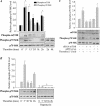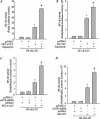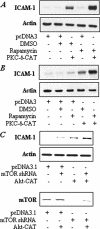Protein kinase C-delta and phosphatidylinositol 3-kinase/Akt activate mammalian target of rapamycin to modulate NF-kappaB activation and intercellular adhesion molecule-1 (ICAM-1) expression in endothelial cells
- PMID: 19074768
- PMCID: PMC2640976
- DOI: 10.1074/jbc.M805032200
Protein kinase C-delta and phosphatidylinositol 3-kinase/Akt activate mammalian target of rapamycin to modulate NF-kappaB activation and intercellular adhesion molecule-1 (ICAM-1) expression in endothelial cells
Abstract
We have shown that the mammalian target of rapamycin (mTOR) down-regulates thrombin-induced ICAM-1 expression in endothelial cells by suppressing the activation of NF-kappaB. However, the mechanisms by which mTOR is activated to modulate these responses remain to be addressed. Here, we show that thrombin engages protein kinase C (PKC)-delta and phosphattidylinositol 3-kinase (PI3K)/Akt pathways to activate mTOR and thereby dampens NF-kappaB activation and intercellular adhesion molecule 1 (ICAM-1) expression. Stimulation of human vascular endothelial cells with thrombin induced the phosphorylation of mTOR and its downstream target p70 S6 kinase in a PKC-delta- and PI3K/Akt-dependent manner. Consistent with this, thrombin-induced phosphorylation of p70 S6 kinase was defective in embryonic fibroblasts from mice with targeted disruption of PKC-delta (Pkc-delta(-)(/)(-)), p85alpha and p85beta subunits of the PI3K (p85alpha(-)(/)(-)beta(-)(/)(-)), or Akt1 and Akt2 (Akt1(-)(/)(-)2(-)(/)(-)). Furthermore, we observed that expression of the constitutively active form of PKC-delta or Akt was sufficient to induce NF-kappaB activation and ICAM-1 expression, and that co-expression of mTOR suppressed these responses. In reciprocal experiments, inhibition/depletion of mTOR augmented NF-kappaB activation and ICAM-1 expression induced by PKC-delta or Akt. In control experiments, increasing or impairing mTOR signaling by the above approaches produced similar effects on NF-kappaB activation and ICAM-1 expression induced by thrombin. Thus, these data reveal an important role of PKC-delta and PI3K/Akt pathways in activating mTOR as an endogenous modulator to ensure a tight regulation of NF-kappaB signaling of ICAM-1 expression in endothelial cells.
Figures








Similar articles
-
Activation of Syk by protein kinase C-delta regulates thrombin-induced intercellular adhesion molecule-1 expression in endothelial cells via tyrosine phosphorylation of RelA/p65.J Biol Chem. 2008 May 23;283(21):14674-84. doi: 10.1074/jbc.M802094200. Epub 2008 Mar 24. J Biol Chem. 2008. PMID: 18362147 Free PMC article.
-
Galpha(q) and Gbetagamma regulate PAR-1 signaling of thrombin-induced NF-kappaB activation and ICAM-1 transcription in endothelial cells.Circ Res. 2002 Sep 6;91(5):398-405. doi: 10.1161/01.res.0000033520.95242.a2. Circ Res. 2002. PMID: 12215488
-
Protein kinase C-delta regulates thrombin-induced ICAM-1 gene expression in endothelial cells via activation of p38 mitogen-activated protein kinase.Mol Cell Biol. 2001 Aug;21(16):5554-65. doi: 10.1128/MCB.21.16.5554-5565.2001. Mol Cell Biol. 2001. PMID: 11463837 Free PMC article.
-
Aldosterone stimulates nuclear factor-kappa B activity and transcription of intercellular adhesion molecule-1 and connective tissue growth factor in rat mesangial cells via serum- and glucocorticoid-inducible protein kinase-1.Clin Exp Nephrol. 2012 Feb;16(1):81-8. doi: 10.1007/s10157-011-0498-x. Epub 2011 Nov 1. Clin Exp Nephrol. 2012. PMID: 22042038 Review.
-
Expanding therapeutic targets in bladder cancer: the PI3K/Akt/mTOR pathway.Lab Invest. 2010 Oct;90(10):1406-14. doi: 10.1038/labinvest.2010.133. Epub 2010 Jul 26. Lab Invest. 2010. PMID: 20661228 Review.
Cited by
-
Rapamycin Attenuates Cardiac Fibrosis in Experimental Uremic Cardiomyopathy by Reducing Marinobufagenin Levels and Inhibiting Downstream Pro-Fibrotic Signaling.J Am Heart Assoc. 2016 Sep 30;5(10):e004106. doi: 10.1161/JAHA.116.004106. J Am Heart Assoc. 2016. PMID: 27694325 Free PMC article.
-
mTOR attenuates the inflammatory response in cardiomyocytes and prevents cardiac dysfunction in pathological hypertrophy.Am J Physiol Cell Physiol. 2010 Dec;299(6):C1256-66. doi: 10.1152/ajpcell.00338.2010. Epub 2010 Sep 22. Am J Physiol Cell Physiol. 2010. PMID: 20861467 Free PMC article.
-
CircNPHP4 in monocyte-derived small extracellular vesicles controls heterogeneous adhesion in coronary heart atherosclerotic disease.Cell Death Dis. 2021 Oct 14;12(10):948. doi: 10.1038/s41419-021-04253-y. Cell Death Dis. 2021. PMID: 34650036 Free PMC article.
-
Dexmedetomidine protects against lung ischemia-reperfusion injury by the PI3K/Akt/HIF-1α signaling pathway.J Anesth. 2016 Oct;30(5):826-33. doi: 10.1007/s00540-016-2214-1. Epub 2016 Jul 13. J Anesth. 2016. PMID: 27412350
-
Luteolin Alleviates the TNF-α-Induced Inflammatory Response of Human Microvascular Endothelial Cells via the Akt/MAPK/NF-κB Pathway.Mediators Inflamm. 2024 Dec 11;2024:6393872. doi: 10.1155/mi/6393872. eCollection 2024. Mediators Inflamm. 2024. PMID: 39698583 Free PMC article.
References
Publication types
MeSH terms
Substances
Grants and funding
LinkOut - more resources
Full Text Sources
Molecular Biology Databases
Miscellaneous

